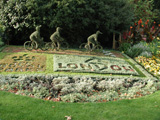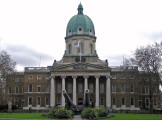Visit the Wonderful Refurbished William Morris Gallery
Originally published in September 2012 in American In Britain
The new tea room in the refurbished William Morris Gallery has a glass roof etched with one of Morris’ most elegant designs, ‘Thistle’. Light pours through the glass and the atmosphere is calm and welcoming. Sitting there visitors can enjoy their tea and look out at the beautiful Lloyd Park Gardens. The restoration of this graceful Grade II listed Georgian villa contains an archive consisting of over 10,000 objects. It is the best and largest Morris collection in the world.
Visit the Wonderful Refurbished William Morris Gallery
“Have nothing in your house that you do not know to be useful, or believe to be beautiful”
William Morris, 1834-1896
By Abby Cronin
I sat in the new tea room in the refurbished William Morris Gallery, looked up at the glass roof etched with one of Morris’ most elegant designs, ‘Thistle’, and reflected on how important it is that once again this Gallery is open to the public. Light pours through the glass and the atmosphere is calm and welcoming. Sitting there visitors can enjoy their tea and look out at the beautiful Lloyd Park Gardens. The restoration of this graceful Grade II listed Georgian villa was designed by architects Pringle Richards Sharratt and is sensitive to the preservation of the building and needs of a public museum. An East Wing extension contains a café and exhibition area and there are new facilities on the second floor for learning and research. In keeping with Morris’ ideals of arts and crafts design, Grayson Perry’s remarkable Walthamstow Tapestry is the first artwork to be displayed in the new exhibition space. Appropriately, it reflects Morris’ devotion to the tradition of the Arts and Crafts Movement. Outside, the gardens have been restored using planting designs inspired by Morris and the18th Century.
First opened in 1950 by the Prime Minister Clement Atlee, the William Morris Gallery was threatened with closure when Waltham Forest Council imposed strict budget cuts in 2007. With an archive consisting of over 10,000 objects, it is the best and largest Morris collection in the world. The threat of closure precipitated a sustained campaign to keep the Gallery open and was led by the former culture secretary, Chris Smith, and many supporters. The Council received thousands of letters of protest from as far afield as California and Australia. More than 5,700 people signed an online petition demanding the preservation of the Morris heritage. But raising funds in these economically challenging times was difficult. Fortunately, the refurbishment was assured when a £1.5m Heritage Lottery Fund grant was matched by the Walthamstow Forest Council. Additional sources came from the Friends of the William Morris Gallery, charitable trusts, sponsors and donors. Celebrations marked the re-opening in August 2012, and now the public is once again invited to view this acclaimed collection of original work by Morris and many of his contemporaries
William Morris was one of Britain’s most prolific and gifted Victorian artisan-craftsmen and social activists. He may be best known for his remarkable wallpapers, but his inexhaustible talents extended to designs for textiles, tapestries, furniture, weaving, embroidery, ceramics and stained glass as well as poetry and the art of the book. Eldest son of a wealthy bill-broker in the City, he moved with the family to Water House (now known as the William Morris Gallery), where he lived from1848 to 1856. He read voraciously in this rural setting, became steeped in Romantic medievalism, absorbed Arthurian legends and found inspiration for Gothic revival architecture as a student in the medieval city of Oxford, where he met his lifelong friend and collaborator, the painter Edward Burne-Jones. These youthful passions contributed to Morris’ disdain for the increasingly mechanised and dehumanising world of Victorian manufacture which he saw all around him. His response was to seek a more communal way of living in which artisan craftsmanship was to be the central activity. He was a founder member of the Arts and Crafts Movement, a supporter of the Pre-Raphaelite Brotherhood, a successful retailer and became a committed socialist. In 1861, together with colleagues, he established ‘the Firm’, Morris, Marshall, Faulkner & Company, initially in Red Lion Square before moving to Oxford Street. The company produced murals, wood carvings, stained glass windows, metalwork, furniture and embroideries. All production techniques were to be accomplished according to the long-abandoned principles of craftsmanship that had governed medieval art. In 1875 the company became Morris & Co under the sole control of Morris. It offered all manner of interior design services such as stained glass, bespoke furniture, textiles and wallpapers to a mainly wealthy middle class clientele. In keeping with his wish to preserve the best of the past, he founded the Society for the Protection of Ancient Buildings, in 1877, a forerunner of today’s National Trust. When he became active in the early British socialist movement in the 1880s, he wrote endless pamphlets and songs to promote the cause. He published the utopian novel, News From Nowhere in 1890, and set up the Kelmscott Press the following year.
The collections are presented in twelve galleries which highlight six themes. Several objects on show have never been seen before. There are interactives, touch screen information points, recordings and videos. The first gallery, to the right of the entrance, sets the scene with an interactive map showing Morris’ connections with Walthamstow. A painting of Morris in his 30s and the Socialist Hall bust convey his imperious presence. An intricate woven tapestry, The Woodpecker Tapestry (1885), is the only one designed by Morris alone.
Many examples of Morris’ early designs are displayed in the second gallery. Original furniture from the Sussex chair range (1860s) is notable for its rush-bottomed seats, simplicity and elegance. The Morris rocker sits aside the Sussex range, and is famous as a classic design. It has been widely copied and adapted by arts and crafts firms such as the Stickley Brothers in the USA. His stunning first wallpaper design, ‘Trellis’, hints at the direction his wallpapers and textiles will take. They soon formed a staple of ‘The Firm’s’ production. There are photos of his wife, Jane Burden, their first marital home, the Red House by architect Philip Webb and a Burne-Jones painting of St George.
Examples of public commissions Morris, Marshall, Faulkner & Company designed for St James’s Palace and the South Kensington Museum (now the V&A) are exhibited. The Green Dining Room commissioned for South Kensington Museum, known today as the Morris Room, is still in use as a dining area in the restaurant. The Workshop gallery is particularly instructive. Here visitors will observe fine details about how products were designed and made. There is a hands-on display that shows the dyeing process and a touch screen virtual exhibit explaining the processes of weaving, carpet knotting, making stained glass and textile printing. Original textile printing blocks are displayed and used to show that several stages of block printing are required to complete a finished design.
A curious visitor might want to know more about the original Morris & Co shop in Oxford Street. Their curiosity will surely be satisfied when they enter the room set featuring merchandise displayed in the manner of Morris’ own time. In this replica shop there are samples of wallpapers, textiles, furniture and much more. Customers could take time to study exactly what they wanted and then place orders, much like our shopping habits today. Upstairs, in the room devoted to the Ideal Book, is a selection of Morris’ writings: pamphlets, poetry and legendary volumes produced when he started the Kelmscott Press. The Kelmscott volumes were made using traditional methods of typographical techniques and printing technology from the 15th century. The Folio Society edition of the Kelmscott Chaucer is on show for visitors to handle. As you move into the room featuring Morris’ Fighting for a Cause—The Campaigning Years, watch the video of well-known scholars discussing his support for many causes, most famously socialism and his concern to save natural landscapes and valued buildings.
You can study outstanding examples of arts and crafts design and craftsmanship in the room dedicated to the Arts and Crafts Movement. The silverware by Ashbee, stained glass by Whall, furniture by Mackmurdo and wallpaper by Voysey are as beautiful today as they were when they were made. The gallery dedicated to Frank Brangwyn is filled with works donated from Brangwyn’s private collection. Brangwyn’s connection with Morris came from his brief apprenticeship in Morris’ workshops. This bequest includes important works by the Pre-Raphaelite Brotherhood ranging from paintings and murals, to carpets and more.
The refurbishment of this wonderful gallery has saved a unique collection of one of Britain’s most accomplished Victorian artist-craftsmen. There is so much to learn here that one visit may feel like a ‘taster’—a peek into the multiple worlds of William Morris and his colleagues. Combine your visit to the William Morris Gallery with a picnic in the Lloyd Park Gardens-a perfect combination for a family outing. Enjoy delicacies from the tea room and have a look at the loo doors covered with Morris wallpapers. The shop offers a selection of books, tea towels cushions and a variety of items with Morris designs. Throughout the refurbished William Morris Gallery there is a joyous sense of design that provides visual delight and is immediately accessible to everyone.
William Morris Gallery – Entry is Free
Lloyd Park, Forest Road, Walthamstow, London E17 4PP
www.wmgallery.org.uk Opening times: 10am – 5pm Wednesday – Sunday Pre-Booked group visits on Tuesdays.
Closed Mondays Public transport links: The Gallery is a 15 minute walk from Walthamstow Central or Blackhorse Road Underground stations – the Victoria Line. Buses: 97, 215, 34, 357 from Walthamstow Central or the 123 from Blackhorse Road.
Images Credit: http://mediacentre.kallaway.co.uk/william-morris-gallery-picture-library.htm
Image of George Street Showroom courtesy William Morris Gallery
Image of William Morris Gallery South courtesy Pringle Richards Sharratt Architects
__________________________________________________________________________
©Abby Cronin
artsjournalist@abbycronin.co.uk
Website: www.abbycronin.co.uk




